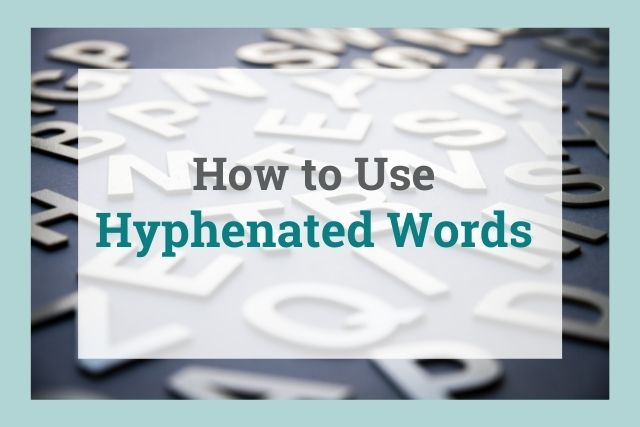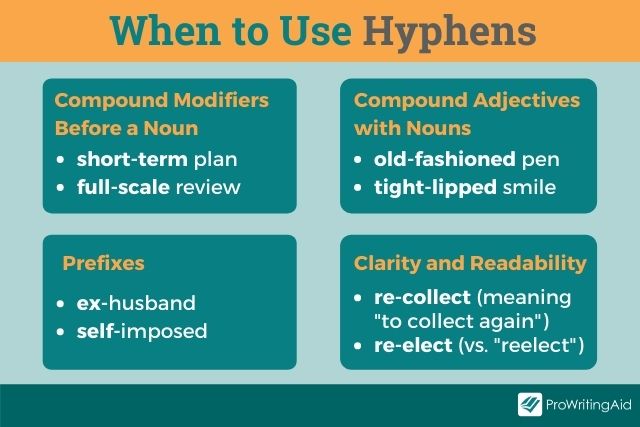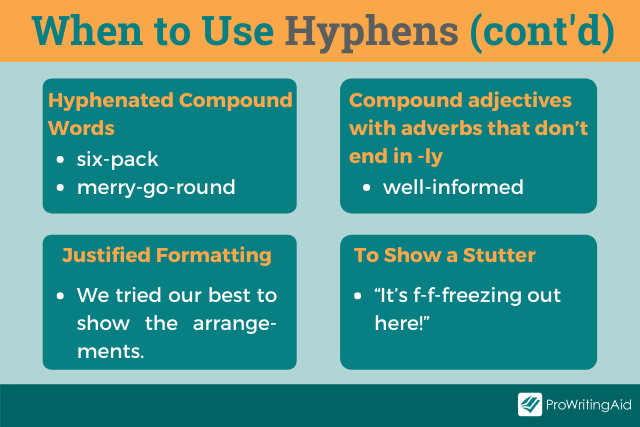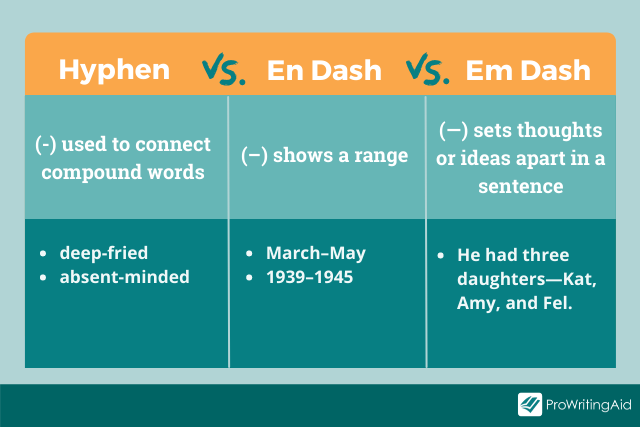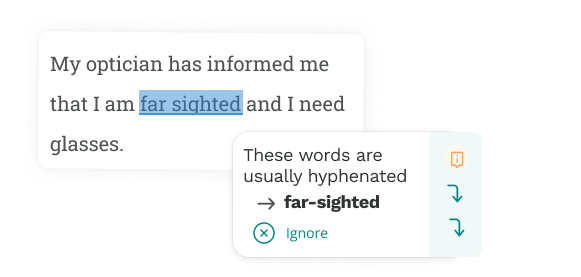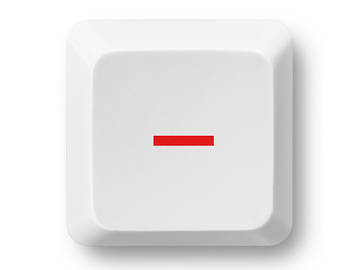Hyphenated words can be confusing for writers! There are many rules and guidelines on when to use hyphens. In today’s article, we’ll take a look at exactly what hyphenated words are and when to use them. We’ll go through plenty of examples so that you can use hyphenated words with confidence in your writing.
What Are Hyphenated Words?
A hyphenated word is a word that contains at least one hyphen. Typically, hyphenated words are compound words, which means the hyphen connects two or more words.
There are other uses of hyphens that we use in writing that aren’t compound words. We’ll cover these examples later in this article.
When to Use Hyphenated Words
We use hyphens to combine certain types of words. These include compound modifiers, such as adjectives and participles. We hyphenate many numbers when they are spelled out in word form, like twenty-one.
Sometimes, we hyphenate words after prefixes, but not every prefix requires a hyphen. How do you know which ones to use? We’ll cover these in more detail in a later section.
Hyphens can also help our writing become clearer. This means that occasionally, we can add hyphens where they aren’t required grammatically. Sometimes, that little punctuation mark can make a huge difference in improving clarity and readability.
Keep reading for detailed explanations of how and when to use hyphens in your writing.
Hyphens vs. Dashes
Many people confuse hyphens and dashes. We even say dashes when we’re using hyphens in web addresses, which makes things even more confusing.
But in English grammar, hyphens and dashes are very different. A hyphen is one short, horizontal line. You can find it next to the 0 on a QWERTY keyboard.
English also has two types of dashes, the en dash and em dash. The em dash (—) is a punctuation mark used between words to break apart thoughts or ideas within a sentence. It’s the length of two dashes.
The en dash (–) shows ranges between numbers, dates, etc. It’s wider than a hyphen and narrower than an em dash.
Many people use hyphens when they should use en dashes, or they’ll use two hyphens in place of an em dash. But these are three distinct punctuation marks and are not interchangeable.
Rules to Follow: What Words Should and Shouldn’t Be Hyphenated?
Hyphenation rules are tricky. Some words must be hyphenated, others should never be hyphenated, and still others can be hyphenated but don’t have to be. We’ll cover some of the basic guidelines for hyphenated words below.
Compound Modifiers
Sometimes when we describe a noun, we use two or more words together in place of one adjective. We call these compound modifiers. You might also hear them called compound adjectives.
There are several types of compound modifiers. One type is adjective + noun (or noun + adjective). We usually hyphenate these words. Here are some examples:
- short-term
- full-scale
- blue-collar
- skin-tight
- rock-hard
- world-famous
Another type of compound adjective combines an adjective with a past participle:
- old-fashioned
- tight-lipped
- good-hearted
- deep-fried
- absent-minded
Adjectives can also combine with a present participle:
- good-looking
- slow-going
- quick-thinking
Nouns can also combine with past and present participles by using a hyphen to make a compound modifier:
- record-breaking
- mind-numbing
- sun-kissed
- air-fried
Some hyphenated compound modifiers are two adjectives, like the examples below:
- fat-free
- bluish-purple
- topsy-turvy
There are also hyphenated compound modifiers that include adverbs, but these get tricky. We’ll cover adverbs in a later section.
Numbers 21 through 99
In English, we hyphenate many two-digit numbers in their written form. Any base-ten higher than twenty plus an integer one through nine is hyphenated. What does this mean? Here are some examples:
- twenty-one
- thirty-two
- forty-three
- fifty-four
- sixty-five
- seventy-six
- eighty-seven
- ninety-eight
We don’t hyphenate teens (e.g. sixteen, seventeen), nor numbers higher than 99.
Let’s look at an example of a large number, so you can see where the hyphen goes:
- 273 = two hundred seventy-three
Notice that we do not hyphenate “two hundred.” We also don’t need the word “and” because in mathematics “and” denotes a decimal. Outside of math, we can place the word “and” to mimic how many people speak. It would look like this:
- two hundred and seventy-three
What about even bigger numbers? Here’s an example:
- 24,535 = twenty-four thousand five hundred [and] thirty-five.
Once again, the “and” is optional. Our hyphenation rules remain the same no matter how large the number gets.
If it’s read like a base-ten plus a number (e.g. twenty-four), we hyphenate. The words “hundred,” “thousand,” “million,” and so on, do not need hyphens.
Compound Adjectives with Numbers
Some compound modifiers contain numbers. These might be periods of time or ages. We hyphenate any compound adjective that contains a number if it precedes a noun. Here are some examples:
- two-week vacation
- three-day weekend
- five-year-old boy
- seventy-three-year-old grandma
- seven-year itch
- fifteenth-century castle
- second-place medal
- third-grade class
If there is a number in a compound adjective, it must have a hyphen. However, if it’s not part of a compound adjective that precedes a noun, we do not hyphenate the word:
- I’m on vacation for two weeks.
- The boy is five years old.
- The castle was built in the fifteenth century.
- She teaches third grade.
- I came in second place.
Always ask yourself how the phrase is functioning. If it’s a compound adjective that contains a number, use a hyphen!
Certain Prefixes
Prefixes are letters or words that attach to the beginning of a word to make a new word. Usually, we do not need to add hyphens after prefixes. However, some prefixes require a hyphen.
When we use the prefix “ex-” to mean “former,” we use a hyphen. Ex- has several meanings as a prefix, and some do not require a hyphen.
If you aren’t sure, try replacing the prefix with the word “former.” If it still makes sense, add a hyphen. If not, the hyphen is probably unnecessary.
- ex-husband
- ex-member
- ex-coworker
So, you wouldn’t need it for words like “excommunicate.” The meaning of the prefix is different.
If you’re using “self-” as a prefix, always add a hyphen. Don’t confuse this with the root word “self” that stands alone as a noun! Here’s what it looks like as a prefix.
- self-loathing
- self-confidence
- self-imposed
You can think of these as compound modifiers instead of a prefix if it helps you remember to use the hyphen.
Likewise, if you’re using “all-” as a prefix, it functions like a hyphenated compound modifier. Let’s look at some examples:
- all-encompassing
- all-powerful
- all-in
You should also hyphenate words that have prefixes before capitalized words, such as “un-American,” “pro-Palestinian,” or “post-Depression era.”
Some words that contain other prefixes have hyphens, but these will occur on an individual basis rather than as a hard and fast rule.
Hyphenating for Clarity
Just when you think hyphenating words was easy once you learn the rules, you find out that some hyphenation rules are optional!
Every now and then, you might write a word that is difficult to read without a hyphen. This often occurs when a prefix shoves two identical letters together.
In these situations, you can add a hyphen to make your writing easier to read. Words like “pre-eclampsia” or “re-elect” are easier to read with the hyphen, even though it’s not necessary.
Hyphens can also help ensure that readers emphasize a syllable correctly to avoid confusion with another word. “Re-collect” will tell the reader you mean “to collect again” rather than “recollect” or “remember.”
Hyphens and Adverbs
Adverbs often combine with other words to form compound modifiers. Sometimes, we need hyphens. Other times, we don’t. How do you remember when to use a hyphen with an adverb?
If the adverb ends in -ly, do not use a hyphen. Take a look at these examples:
- beautifully dressed
- heavily laced
- happily married
- horribly disfigured
- poorly written
But not all adverbs end in -ly. Here are some examples of compound modifiers with adverbs that do need a hyphen:
- well-informed
- never-ending
- far-sighted
- even-keeled
If you aren’t sure when to use a hyphen with adverbs, ProWritingAid can help. The Grammar Report will point out missing and unnecessary hyphens.
Examples of Hyphenated Compound Words
Compound words are words that are comprised of two or more words, often nouns, to create a new word. There are open compound words, closed compound words, and hyphenated compound words.
Open compound words include words such as coffee table, dining room, high school, ice cream, and peanut butter. There’s a space between these words, but both parts of the word are necessary. Peanut and butter are two different things than peanut butter.
Closed compound words push words together without a space or hyphen. Words such as mailbox, skateboard, sunshine, bookshop, and firefighter are closed compound words.
Some compound words used to be hyphenated but eventually the hyphen went out of fashion.
Hyphenated compound words use a hyphen to connect the words. Here are some examples:
- six-pack
- merry-go-round
- runner-up
- king-size
- editor-in-chief
Hyphenated compound words like this differ from compound modifiers because they are nouns that are always hyphenated. They don’t function as adjectives or modifiers.
Other Uses of Hyphens in Writing
Hyphens have other uses in English writing, too. They don’t always form new words or connect parts of speech. Sometimes, they are used for formatting purposes.
When we justify text, or line up both margins, words can get cut off. While you can place a long word on the next line, this can look messy and uneven, particularly in books. Hyphens are used to cut words off between lines.
Hyphens can also denote a stutter or stammer in dialogue, as in this example:
- “It’s f-f-freezing out here!”
These are formatting rules more than grammar rules, but it’s important to know that we can use hyphens in this way.
Conclusion on Words with Hyphens
Hyphens are a tiny punctuation mark that nonetheless pack a punch. Always ensure you are using a hyphen instead of an en dash or em dash when hyphenating words.
Remember to use hyphens in most compound modifiers, and always run your writing through an editing program like ProWritingAid to catch any hyphen errors.
Take your writing to the next level:
20 Editing Tips from Professional Writers
Whether you are writing a novel, essay, article, or email, good writing is an essential part of communicating your ideas.
This guide contains the 20 most important writing tips and techniques from a wide range of professional writers.

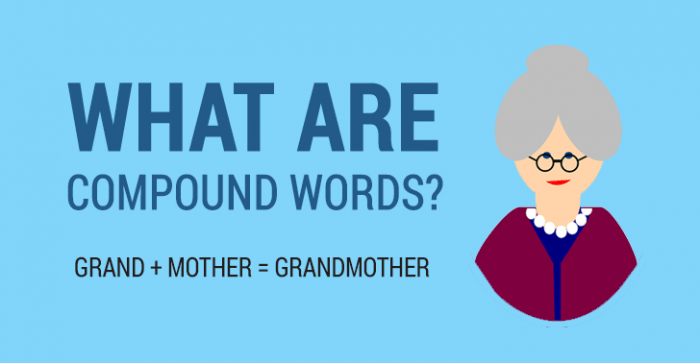
What are Compound Words?
It’s best to define compound words with an example:
Grand + Mother
On their own, both these words have separate meanings. But when you put these two words together, it creates an entirely different word and meaning.
Grandmother
For compound words, when you put two different words together, it forms another word and meaning. There are different types of compound words. For example, compound words can have hyphens, spaces, or no spaces at all between the two words.
Types of Compound Words
Over time, English has morphed itself. As a result, people have created new types of compound words. In turn, this language gets passed along and circulated to what it is today.
In terms of compound words, they’ve transformed into various types. For example, compound words can have hyphens, spaces, or no spaces at all between the two words. There are 3 types of compound words:
- Hyphenated Compound Words
- Closed Compound Words
- Open Compound Words
Below, we have added lists of examples for all the types of compound words.
Hyphenated Compound Words Examples
Hyphenated compound words place a hyphen between the two words. For example, “well-being” is a hyphenated compound word because it connects two words together with a hyphen.
HYPHENATED COMPOUND WORDS
- High-speed
- Empty-handed
- Mass-production
- High-tech
- Deep-fried
- Left-handed
- In-depth
- Full-length
- Part-time
- Time-saving
- North-east
- Sun-dried
- Long-haired
Closed Compound Words Examples
Closed compound words don’t have any spaces between the two combined words. For example, “playground” is a closed compound word because it doesn’t have a space between it.
CLOSED COMPOUND WORDS
- Playground
- Footprint
- Fishbowl
- Grasshopper
- Bookmark
- Keyhole
- Bowtie
- Popcorn
- Basketball
- Horseshoe
- Keyboard
- Notepad
- Skateboard
Open Compound Words Examples
Open compound words put two words together to create a meaningful weird but use a space to separate them. For instance, high school is an open compound word.
OPEN COMPOUND WORDS
- High school
- Living room
- Roller coaster
- Peanut butter
- First aid
- Web page
- Hot dog
- Voice mail
- Table cloth
- Fire drill
- Ice cream
What’s Next?
What do Superman, Robocop, and Catwoman all have in common?
They’re superheroes! Yes. But they’re also all compound words too. Actually, there are compound words everywhere.
And they’re tons of fun to teach with our free compound words worksheets. What are some of your favorite compound words?
And if you want to teach compound words, check out our free compound words worksheets that you can use in your classroom today.
The forms of compounds (two words used together) in English are not fixed. Some terms have moved from being open compounds (base ball) to hyphenated (base-ball) to closed (baseball), a pattern that reflects familiarity and frequency of usage. Hyphens are often used when a compound modifies a noun (“sun-bleached curtains,” “fire-roasted tomatoes”) but not when -ly adverbs are used (“lightly salted peanuts”).
Among the correspondence we receive at Merriam-Webster, a significant amount of it comes from people asking how to style a particular compound word. Should it be two words? One word? Should a hyphen be inserted between the two components?
The definitive answer is: it’s complicated.
Open, Hyphenated, and Closed Compounds
For much of the dictionary’s history, a compound word was shown in only one form—closed, hyphenated, or open—even if there were examples of two or, sometimes, all three forms in use. This practice was necessitated by the limitations of page space: it simply wasn’t practical to show all of the possible permutations of a compound word at the expense of other information in a print dictionary entry. You saw only one styling—the one that occurred most frequently within a sample of evidence. If that evidence changed, then the headword was revised.
Even in the digital age, this is true for many entries. The term tongue twister, for example, is shown as an open (two-word) compound, even though there is plenty of evidence for tongue-twister in the wild. The same is true for terms like vice president and tape measure. Absence of a particular compound style in the dictionary doesn’t mean it’s not in use; it only means it’s much less common.
Historically, a lot of compounds follow the pattern of entering English as open compounds, then gradually take on hyphenation and eventually a closed form as they become more familiar. There was a time, after all, when baseball was spelled as base ball. As the sport took hold in the American consciousness, it gradually began to be spelled with a hyphen (base-ball), but now any form other than the solid compound baseball looks like an affectation.
Similarly, lifestyle, boilerplate, doorbell, screwdriver, tailwind, rowboat, and postcard all had eras when they were encountered more commonly as open or hyphenated compounds. Now we almost invariably see them closed, and that’s the only styling they are shown with in the dictionary.
Even words that might seem comparable can show disparate forms. You are likely, for example, to spell shoelace, postcard, rattlesnake, and doorknob as closed compounds, but you’re also likely to find shoe tree, post office, garter snake, and door handle as open. You’re more apt to find a hyphen in double-header or double-decker than in double play. And front yard and front seat tend to appear as two words, but backyard and backseat as one.
What all of this means is that there is a great deal of fluidity when it comes to the styling of compounds and whether a particular compound is open, hyphenated, or closed. So much fluidity, in fact, that the dictionary cannot always provide a cut-and-dried answer, as much as it tries.
But do not despair: there are a smattering of guidelines that are for the most part consistent and that can help you.
(Loose) Guidelines
For example, when a compound that is usually left open is used to modify another noun, that compound will usually take a hyphen. So you can speak of a person who loves science fiction going to a science-fiction convention. Same with a video-game collector, a food-truck business, a pet-store employee, or even adjectives made from phrases, like made-for-TV movie or over-the-counter medication.
(Even in these instances, the hyphen is sometimes dropped for very common terms that aren’t likely to be misunderstood, like real estate agent or health care legislation).
Hyphens also work well with compound adjectives that end in a participle: a funny-looking badger, a sun-bleached roof, fire-roasted tomatoes, a money-grubbing thief.
Hyphens tend not be used for adjectives that are modified by adverbs, even when they come before nouns: lightly salted peanuts, distantly related cousins, a poorly written sentence.
For most other instances, the best strategy may be to trust what you think looks right. Some writers are more comfortable lumping together compounds than others. Some think a hyphen is visually messy. Note, though, that whether or not you choose to style a compound as one word or two might convey something about your familiarity with the word (or lack thereof). One dictionary that shall not be named was a bit notorious for showing the headword Web site long after most of the civilized world was using website. They wised up, eventually.
Compound words usually consist of two words (two components) that may be written separately, with a hyphen, or as one word. Rules and recommendations for the use of the hyphen with compound words are rather complicated and subject to change, so it is best to consult a good up-to-date dictionary.
Examples of compound words:
toothpaste; flashlight; night club
go out; light-green; twenty-five
Note: Both components (both words) in compound words are stressed. In this material, capital letters show the syllable / word with primary stress. Secondary stress is on the other component of the compound word. Secondary stress is not shown here. (You can listen to compound words in Listening for Stress in Compound Words (AmE) in the section Phonetics.)
Note: English terms
The terms «open compound; closed compound; hyphenated compound» are often used in English linguistic materials.
Compound words written as two separate words are called «open compounds». For example: credit card; high school; light bulb; post office.
Compound words written as one word are called «closed compounds» (or «solid compounds»). For example: airplane, highland, lighthouse, railroad.
Compound words with a hyphen are called «hyphenated compounds». For example: bad-tempered; good-looking; high-minded; light-hearted.
Compound nouns
Compound nouns are very common in English. Many dictionaries give compound nouns as separate entries, but their stress is not always indicated. Use the links to online dictionaries on the page Vocabulary to check the transcription of compound nouns and to listen to their pronunciation.
In compound nouns, both components (both words) are stressed. Primary stress falls on the first component (the first word), even if the two words are written separately. Usually, the second component is a noun. The first component may be a noun, a gerund, an adjective, or a verb.
FOOTball; ARMchair; MAILbox
PHOtograph; TELegram; TELescope
WRITing desk; SWIMming pool
HIGH school; HIGHway; HOT dog
CRYbaby; PUSHcart; BREAKthrough
Primary stress on the first component
Primary stress on the first component reflects the tight connection between the two parts of a compound noun. This stress is the main distinguishing mark between a compound noun (stress on the first component) and a regular / free Attribute + Noun combination in which primary stress is on the second word (on the noun).
Compare these pairs in which the first word combination is a compound noun (tight connection between the two components; primary stress on the first component; secondary stress on the second component), and the second is a free combination of an adjective or participle with a noun (loose connection between the two words; primary stress on the second word; secondary stress on the first word).
GREENhouse – green HOUSE
BLACKboard – black BOARD
DARKroom – dark ROOM
EVEning dress – evening SKY
WALKing stick – walking PEOPLE
READing test – reading BOY
SINGing lesson – singing GIRL
MOBile phone – mobile PERson
STONE Age – stone BUILDing
HOT dog – hot TEA
PAPer knife – paper BAG
ENGlish teacher – English TEACHer
SUMmertime – summer CLOTHES
SUMmer camp – summer SPORTS
NIGHT school, EVEning school – night HOURS, evening HOURS
There are some exceptions from the standard pattern of compound noun stress, for example, manKIND. In some cases, there are two variants of stress in compound nouns, for example, well-BEing; WELL-being.
Note: Most compound nouns are usually written as one word (without a hyphen) or as two separate words. But some compound nouns are hyphenated. For example: cease-fire; court-martial; cross-purposes; father-in-law; mother-in-law; great-grandfather; great-grandson; self-control; self-service; well-wisher.
Compound nouns written as two words
Language learners usually have no problem with stress in compound nouns written as single words (POSTcard; PANcake) but may have difficulty identifying compound nouns written as two separate words (CREDit card; WEDding cake).
Examples of compound nouns that are usually written as two separate words are given below. Primary stress is on the first word; secondary stress is on the second word.
FOOTball player; CAR dealer
FIRE fighter; SMOKE detector
MATH student; GRAMMar book
CONference hall; MEDical school
MINeral water; FRUIT juice
PORK chop; CARVing knife
FRYing pan; dePARTment store
LIVing room; LIGHT bulb
TRAIN station; BUS stop
PARKing lot; DRIVing test
eCONomy class; dePARture time
CREDit card; SAVings account
CELL phone; PHONE call
POST office; TELephone book
BLOOD type; HEALTH check
DRINKing problem; HEART disease
DEATH sentence; LIFE insurance
HORror movie; GHOST story
AIR pressure; WEATHer report
Note: The rules of adding the plural ending s/es and the apostrophe to compound nouns are described in Adding the Ending s/es to Nouns and Verbs and Adding the Apostrophe to Nouns in the section Writing.
Phrasal verbs with postpositions
Phrasal verbs with postpositions (with adverbial particles) are compound verbs in which both components are stressed, usually with stronger stress on the postposition.
‘fall aPART; ‘turn aWAY
‘come BACK; ‘come IN
‘break DOWN; ‘break IN
‘break THROUGH; ‘go ON
‘take OFF; ‘look OUT;
‘move OVer; ‘give UP
‘make UP; ‘bring UP
(See examples with these phrasal verbs in the subsection Phrasal Verbs in the section Idioms.)
If a compound noun is formed from a phrasal verb, primary stress in it falls on the first component, and the noun is usually written as a single word or with a hyphen.
GETaway; COMEback
BREAKdown; BREAKthrough
LOOKout; OUTlook
DOWNfall; UPbringing
MAKE-up; TAKE(-)off
Compound adjectives
Both parts of compound adjectives are stressed. Stronger stress usually falls on the second component of two-word compound adjectives.
dark-GREEN; light-BROWN
grayish-BLUE; bright-RED
red-HOT; white-HOT
absent-MINDed; low-SPIRited
old-FASHioned; cold-BLOODed
well-KNOWN; well-DRESSed
broken-HEARTed; HEARTbroken
easyGOing, easy-GOing
good-LOOKing; longSTANDing
snow-WHITE; sky-BLUE
stone-BLIND; ice-COLD
duty-FREE; skin-DEEP
man-MADE; handMADE
half-DEAD; half-FULL
self-CONscious; self-CONfident
Note: Stress on the noun
If one of the components in a two-word adjective is a noun, stronger stress may fall on the noun, irrespective of whether it is the first or second component.
COLor-blind; WATerproof
high-CLASS; high-SPEED
low-COST; low-KEY
LAW-abiding; EARsplitting
off-COLor
off-BALance
AIRsick; SEAsick
Note: Hyphen with compound adjectives
A compound adjective before the noun that it modifies is written with a hyphen: a dark-blue dress; a reddish-brown rug; a well-known writer; a well-read student.
Many compound adjectives in the position after the linking verb are written as two separate words, without a hyphen. Examples: Her dress is dark blue. The rug is reddish brown. This writer is well known.
Many other compound adjectives keep the hyphen in such cases: He is absent-minded and old-fashioned. She is good-looking and good-natured. She is well-read in English poetry.
Combinations of adverbs ending in «ly» with adjectives or participles are not hyphenated: a widely known fact; entirely white hair; a highly paid lawyer.
If a compound noun written as two separate words is used as an attribute before another noun, such an attribute is usually hyphenated: a high-school teacher; the living-room window; a parking-lot attendant.
Compound numerals
In compound numerals consisting of several words, each component / each word is stressed (except «and»); the last component receives the strongest stress.
Compound numerals from twenty-one to ninety-nine are hyphenated. Fractions in the function of nouns may be with or without a hyphen.
thirTEEN; sevenTEEN
fifTEENTH; eighTEENTH
twenty-THREE; forty-SIX
fifty-SEVen; ninety-EIGHT
sixty-SECond; seventy-FIFTH
five HUNdred and thirty-TWO
three hundred THOUsand
one-HALF, one HALF
two-THIRDS, two THIRDS
one twenty-FIFTH
twenty-three HUNdredths
(Read more about the pronunciation of numbers in Numbers and Numerals in the section Miscellany.)
Ударение в сложных словах
Сложные слова обычно состоят из двух слов (двух компонентов), которые могут быть написаны раздельно (в два слова), с дефисом, или слитно (как одно слово). Правила и рекомендации по употреблению дефиса со сложными словами довольно сложны и подвержены изменению, поэтому лучше всего проверять написание в хорошем современном словаре.
Примеры сложных слов:
зубная паста; фонарик; ночной клуб
выйти; светло-зелёный; двадцать пять
Примечание: Оба компонента (оба слова) в сложных словах ударные. В этом материале, заглавные буквы показывают слог / слово с главным ударением. Второстепенное ударение на другом компоненте сложного слова. Второстепенное ударение не показано здесь. (Вы можете послушать сложные слова в материале Listening for Stress in Compound Words (AmE) в разделе Phonetics.)
Примечание: Английские термины
Термины «open compound; closed compound; hyphenated compound» часто употребляются в английских лингвистических материалах.
Сложные слова, которые пишутся раздельно, в два слова, называются «open compounds». Например: credit card; high school; light bulb; post office.
Сложные слова, которые пишутся слитно, как одно слово, называются «closed compounds» (или «solid compounds»). Например: airplane, highland, lighthouse, railroad.
Сложные слова с дефисом называются «hyphenated compounds». Например: bad-tempered; good-looking; high-minded; light-hearted.
Сложные существительные
Сложные существительные очень употребительны в английском языке. Многие словари дают сложные существительные как отдельные словарные статьи, но их ударение не всегда указано. Используйте ссылки на онлайн-словари на странице Vocabulary, чтобы проверить транскрипцию сложных существительных и послушать их произношение.
В сложных существительных оба компонента (оба слова) ударные. Главное ударение падает на первый компонент (первое слово), даже если эти два слова пишутся раздельно. Обычно, второй компонент – существительное. Первым компонентом может быть существительное, герундий, прилагательное или глагол.
футбол; кресло; почтовый ящик
фотография; телеграмма; телескоп
письменный стол; плавательный бассейн
средняя школа; шоссе; сосиска
плакса; ручная тележка; прорыв
Главное ударение на первом компоненте
Главное ударение на первом компоненте отражает крепкую связь между двумя частями сложного существительного. Это ударение является главным различительным признаком между сложным существительным (ударение на первом компоненте) и обычным / свободным сочетанием Определение + существительное, в котором главное ударение ставится на втором слове (на существительном).
Сравните эти пары, в которых первое словосочетание – сложное существительное (крепкая связь между двумя компонентами; главное ударение на первом компоненте; второстепенное ударение на втором компоненте), а второе – свободное сочетание прилагательного или причастия с существительным (не крепкая связь между двумя словами; главное ударение на втором слове; второстепенное ударение на первом слове).
теплица, парник – зелёный дом (цвет)
школьная доска – чёрная доска (цвет)
комната для проявки фото – тёмная комната
вечернее платье (тип одежды) – вечернее небо
трость для ходьбы – гуляющие люди
тест по чтению – читающий мальчик
урок пения – поющая девочка
мобильный телефон – мобильный человек
Каменный век – каменное здание
сосиска (в булочке) – горячий чай
нож для бумаги – бумажный пакет
учитель английского – учитель-англичанин
лето, летний сезон – летняя одежда
летний лагерь (для детей) – летние виды спорта
вечерняя школа – ночные часы, вечерние часы (период времени)
Есть некоторые исключения из стандартной модели ударения сложных существительных, например, manKIND (человечество). В некоторых случаях есть два варианта ударения в сложных словах, например, well-BEing; WELL-being (благосостояние).
Примечание: Большинство сложных существительных обычно пишутся слитно, как одно слово (без дефиса) или раздельно, как два отдельных слова. Но некоторые сложные существительные пишутся с дефисом. Например: cease-fire; court-martial; cross-purposes; father-in-law; mother-in-law; great-grandfather; great-grandson; self-control; self-service; well-wisher.
Сложные существительные с написанием в два слова
Изучающие язык обычно не имеют проблем с ударением в сложных существительных, которые пишутся как одно слово (POSTcard; PANcake), но могут испытывать трудность с узнаванием сложных существительных, которые пишутся как два отдельных слова (CREDit card; WEDding cake).
Примеры сложных существительных, которые обычно пишутся раздельно, как два слова, даны ниже. Главное ударение на первом слове; второстепенное ударение на втором слове.
футболист; торговец автомобилями
пожарный; дымоуловитель
студент математики; учебник грамматики
зал заседаний; мединститут
минеральная вода; фруктовый сок
свиная отбивная; нож для разделки мяса
сковорода; универмаг
гостиная; электрическая лампочка
вокзал; автобусная остановка
автостоянка; экзамен по вождению
эконом-класс; время отправления
кредитная карточка; сберегательный счёт
сотовый телефон; телефонный звонок
почта; телефонный справочник
группа крови; медосмотр
злоупотребление алкоголем; болезнь сердца
смертный приговор; страхование жизни
фильм ужасов; рассказ с привидениями
давление воздуха; прогноз погоды
Примечание: Правила прибавления окончания мн. числа s/es и апострофа к сложным существительным описаны в материалах Adding the Ending s/es to Nouns and Verbs и Adding the Apostrophe to Nouns в разделе Writing.
Фразовые глаголы с послелогами
Фразовые глаголы с послелогами (с наречными частицами) – это сложные глаголы, в которых оба компонента ударные, обычно с более сильным ударением на послелоге.
развалиться на части; отвернуться
вернуться; войти
сломаться; ворваться
прорваться, пробиться; продолжать
взлететь; выглянуть
подвинуться; отказаться
накладывать косметику; воспитывать (детей)
(Посмотрите примеры с этими фразовыми глаголами в подразделе Phrasal Verbs в разделе Idioms.)
Если от фразового глагола образуется сложное существительное, то главное ударение в нём ставится на первом компоненте, и это существительное обычно пишется как одно слово (слитно) или с дефисом.
побег; возвращение
поломка; прорыв
пункт наблюдения; вид, перспектива
падение; воспитание
косметика; взлёт
Сложные прилагательные
Обе части сложного прилагательного ударные. Более сильное ударение обычно ставится на втором компоненте сложных прилагательных, состоящих из двух слов.
темно-зелёный; светло-коричневый
серо-голубой; ярко-красный
раскалённый докрасна; раскалённый добела
рассеянный; удручённый
старомодный; хладнокровный
хорошо известный; хорошо одетый
с разбитым сердцем; с разбитым сердцем
с лёгким характером
привлекательный; давний, длительный
белоснежный; небесно-голубой
совершенно слепой; ледяной
беспошлинный; неглубокий, поверхностный
созданный человеком; сделанный вручную
полумёртвый; наполовину полный
мнительный; самоуверенный
Примечание: Ударение на существительном
Если в сложном прилагательном один из компонентов существительное, более сильное ударение может падать на существительное, независимо от того, является оно первым или вторым компонентом.
не различающий цвета; водонепроницаемый
высокого класса; скоростной
недорогой; неброский
законопослушный; оглушительный
нестандартного цвета; сомнительный
несбалансированный
страдающий воздушной болезнью; страдающий морской болезнью
Примечание: Дефис со сложными прилагательными
Сложное прилагательное перед определяемым существительным пишется через чёрточку: a dark-blue dress, a reddish-brown rug, a well-known writer, a well-read student (начитанный студент).
Многие сложные прилагательные в положении после глагола-связки пишутся как два отдельных слова, без дефиса. Примеры: Her dress is dark blue. The rug is reddish brown. This writer is well known.
Многие другие сложные прилагательные сохраняют дефис в таких случаях: He is absent-minded and old-fashioned. She is good-looking and good-natured. She is well-read in English poetry.
Сочетания наречий, оканчивающихся на «ly», с прилагательными или причастиями пишутся без дефиса: a widely known fact; entirely white hair; a highly paid lawyer.
Если сложное существительное, которое пишется раздельно, как два слова, употреблено как определение перед другим существительным, такое определение обычно пишется через дефис: a high-school teacher; the living-room window; a parking-lot attendant.
Сложные числительные
В сложных числительных, состоящих из нескольких слов, каждый компонент / каждое слово ударное (кроме «and»); последний компонент получает самое сильное ударение.
Сложные числительные от двадцати одного до девяноста девяти пишутся через дефис. Дроби в функции существительных могут быть с дефисом или без него.
тринадцать; семнадцать
пятнадцатый; восемнадцатый
двадцать три; сорок шесть
пятьдесят семь; девяносто восемь
шестьдесят второй; семьдесят пятый
пятьсот тридцать два
триста тысяч
одна вторая
две третьих
одна двадцать пятая
двадцать три сотых
(Прочитайте ещё о произношении чисел в материале Numbers and Numerals в разделе Miscellany.)
It’s enough to drive even the most exacting writers, proofers, and editors a little batty sometimes: More than one descriptive word precedes a noun, forming what we call a compound modifier. Do we need to hyphenate the words, or are they well enough left alone? What if we have two words modifying another word and all three describe the same noun, creating a package that begs for punctuation?
Sometimes the solution is simple, as we’ve covered in our hyphen rules. Rule 1 advises hyphenating two or more words acting as a single idea when they come before a noun (late-arriving train, ne’er-do-well teenager, one-of-a-kind invention).
Exceptions to this rule are compound modifiers that include adverbs such as much and very as well as any -ly adverb (much maligned administrator, very good cake, easily remembered song).
We also wouldn’t hyphenate a compound that’s an obvious unit such as most proper nouns (Social Security check) and foreign expressions (quid pro quo exchange).
Open Compound: Hyphen or No Hyphen?
When a two-word descriptor takes the form of a compound noun (e.g., real estate, high school, sales tax), hyphenation becomes a matter of preference. Some writers and editors identify the compound nouns as clearly understood units while others still hyphenate them to maintain stylistic consistency and remove any chance of confusion.
Examples:
real estate advisor vs. real-estate advisor
high school dance vs. high-school dance
sales tax increase vs. sales-tax increase
In Rule 5 of Hyphens, we also emphasize including a hyphen with a compound modifier anytime omitting one could lead to ambiguity.
Potentially misaimed: Springfield has little town charm. (If we omit the hyphen, we’re suggesting Springfield lacks appeal. Is that what we want to say?)
Clearer with hyphen: Springfield has little-town charm. (The punctuation establishes that Springfield has the charm of a small, cozy town.)
Potentially misaimed: That is a fast running machine. (Is it a machine that runs fast, or a running machine [i.e., a treadmill] that operates faster than others?)
Clearer with hyphen: That is a fast-running machine. (a machine that runs fast)
Open Compound: Hyphen or En Dash?
The guidelines thus far help define and apply hyphenation of preceding descriptors. The next question concerns what to do when we run into phrases such as stippling technique influenced painter and apple orchard scented candle.
If we employ basic hyphenation, we wind up with phrases such as stippling-technique-influenced painter and apple-orchard-scented candle. While such punctuation can be acceptable, it can also be unsightly and distracting. Some editors feel it muddles phrasal components of careful writing.
To solve this, some style guides turn to the en dash, which is longer than the hyphen and shorter than the em dash. We have explored the mark in En Dash: What Is an En Dash? The article points out that many daily publications do not use the en dash for compound descriptors. Conversely, books and other formal publications will include it, although sparingly.
In careful writing, the hyphen connects immediately related words (late-arriving train, little-town charm). The en dash more clearly identifies descriptive units within modifiers of three or more words when they include a compound noun. In stippling technique influenced painter, stippling technique is a compound noun modifying influenced. It therefore remains open (no punctuation); it is then connected as a multipart modifier to influenced with the en dash. In total, the three descriptive words complete the noun phrase stippling technique–influenced painter.
If we write other mutations such as stippling technique-influenced painter and stippling-technique–influenced painter, we compromise accurately marked word relationships and correct treatment of parts of speech. We also create traffic jams of punctuation.
The same principles apply to apple orchard–scented candle. Apple orchard is the compound noun left open to identify it as such. The en dash then connects the compound unit to scented to complete the three-word modifier of candle.
In step with all of our grammatical principles, our aim is always precision and clarity. While you may not see them working together very often, further understanding the functions of the hyphen and the en dash will sharpen your mission to write with precision.
Pop Quiz
In the following sentences, identify whether the italicized phrase would require a hyphen, an en dash, or no punctuation because it is a compound noun.
1. The expensive looking car must belong to one of those pro athletes over there.
a) hyphen: expensive-looking car
b) en dash: expensive–looking car
c) no punctuation: expensive looking car
2. The corn starch amended food is cheaper to produce but now lesser in protein.
a) hyphen: corn-starch amended food
b) en dash: corn starch–amended food
c) no punctuation: corn starch amended food
3. I’ve been waiting at the train station for more than two hours.
a) hyphen: train-station
b) en dash: train–station
c) no punctuation: train station
Pop Quiz Answers
1. a) The expensive-looking car must belong to one of those pro athletes over there.
Explanation: expensive-looking is a compound modifier of car.
2. b) The corn starch–amended food is cheaper to produce but now a lesser source of protein.
Explanation: the words corn starch amended modify food, and corn starch is a compound noun describing amended.
3. c) I’ve been waiting at the train station for more than two hours.
Explanation: train station is a compound noun not modifying another word.
Advertisement
If the article or the existing discussions do not address a thought or question you have on the subject, please use the «Comment» box at the bottom of this page.

